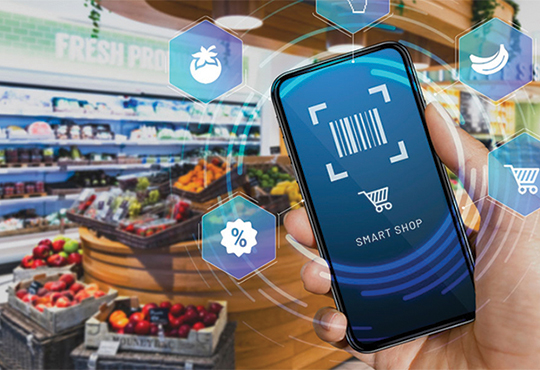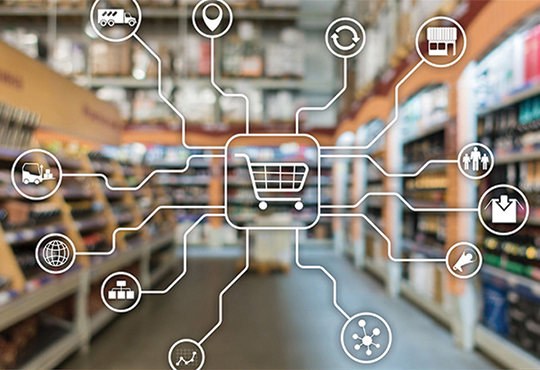
Embracing Cashierless Technology for a Seamless Experience
Roshan Akthar, Content Writer | Tuesday, 30 January 2024, 13:39 IST
 Cashier-less technology, often referred to as autonomous checkout systems, represents a transformative shift in the retail landscape. This innovative technology aims to streamline the shopping experience by eliminating traditional checkout counters and cashiers. Leveraging a combination of advanced sensors, computer vision, and artificial intelligence, these systems allow customers to grab items, walk out, and have their purchases automatically charged to their accounts. According to a report by Juniper Research, the cashier-less market is expected to grow significantly, reaching $387 billion in transactions globally by 2025. This rapid expansion can be attributed to the convenience it offers consumers and the operational efficiency it brings to retailers. In this blog, we’ll explore the detailed points and facts of checkoutless technology and how it’s impacting the retail industry.
Cashier-less technology, often referred to as autonomous checkout systems, represents a transformative shift in the retail landscape. This innovative technology aims to streamline the shopping experience by eliminating traditional checkout counters and cashiers. Leveraging a combination of advanced sensors, computer vision, and artificial intelligence, these systems allow customers to grab items, walk out, and have their purchases automatically charged to their accounts. According to a report by Juniper Research, the cashier-less market is expected to grow significantly, reaching $387 billion in transactions globally by 2025. This rapid expansion can be attributed to the convenience it offers consumers and the operational efficiency it brings to retailers. In this blog, we’ll explore the detailed points and facts of checkoutless technology and how it’s impacting the retail industry.
The key statistics driving the adoption of cashier-less technology include a notable reduction in checkout times. Studies indicate that customers using autonomous checkout systems spend 15% less time completing their purchases compared to traditional methods. Additionally, the technology minimizes friction points in the shopping process, leading to increased customer satisfaction.
The Rise of Cashier-less Technology
One key advantage of cashier-less technology is the significant reduction in waiting times. Traditional checkout lines can be a source of frustration for customers, leading to a lessthan-optimal shopping experience. Cashier-less systems eliminate this bottleneck, allowing individuals to quickly complete their purchases and leave the store, promoting efficiency and customer satisfaction.
The integration of computer vision and machine learning algorithms ensures accurate tracking of items selected by the customers. As customers move through the store, the technology identifies and adds products to their virtual carts. This precision reduces the likelihood of errors in billing and enhances the overall reliability of the system.
Strategically placed sensors in the store encourage sensor fusion, combining data from different sources to improve accuracy. Weight sensors on the shelves detect when an object is lifted or put back, which confirms the visual data from the cameras. This synergy ensures a seamless and accurate understanding of every customer and product interaction.
AI algorithms process this combination of data, distinguish different products from each other, trac- king their movement and link them to a specific buyer. Machine learning models continuously improve accuracy over time & adapts to changing store layouts and customer behaviors. Once purchases are made, customers can simply leave the store and the cashless system automatically charges their linked payment method. Digital receipts are sent directly to the user's mobile app, providing a seamless, efficient and frictionless shopping experience.
The lack of traditional checkout lines doesn't mean customers can walk away without paying. Instead, payments are processed seamlessly through the associated mobile app or linked payment method. The whole process is designed intuitively and efficiently so that buyers can enjoy the guide.
“Despite the dilemmas that we all have regarding the use of chatbots, AI seems to be the way forward for customer experience in the future” - Rakesh Jaitley, Senior Sales Director, Customer Experience Solutions, Oracle India
Benefits for Retailers & Consumers
The adoption of cashless technology brings countless benefits for both retailers and consumers. The efficiency of the operations of traders will improve significantly. Reducing labor costs, moving staff into more strategic roles and minimizing cash bottlenecks contribute to more efficient and cost-effective operations.
On the side of the consumer, the main advantage is saving time. Shoppers can walk into the store, grab the items they need and leave without waiting in line. This not only increases convenience, but also contributes to an overall positive shopping experience. In addition, the technology enables personalized recommendations based on customer preferences and purchase history, creating a personalized and more enjoyable shopping experience.
 Challenges & Concerns
Challenges & Concerns
While the promise of cashless technology is attractive, it is not without its challenges and concerns. In the foreground are data protection issues related to comprehensive monitoring of customer transactions and data security of payment information. Retailers must address these issues through effective security measures and open communication with customers. There are also technical challenges to overcome, such as ensuring accurate product identification and preventing theft. As the technology continues to advance, addressing these challenges will be critical to widespread adoption.
The Future of Retail
Cashless technology is poised to shape the future of retail. As more retailers experiment and adopt this innovative approach, it is likely to become an industry staple. The convenience it offers responds to the changing expectations of today's consumers, who are looking for a hassle-free and personalized shopping experience.
The future of cashless technology looks promising and will revolutionize the retail experience. Thanks to advanced computer vision, sensor fusion and artificial intelligence, thesesystems enable seamless shopping without traditional checkout processes. Retail giants and innovative startups are investing heavily in free solutions to improve efficiency and reduce customer wait times. As technology advances, we can foreseethe further development of these systems, whichcan expand from grocery stores and small-scale facilities to larger retail environments. However, there are still significant privacy, data security and employment issues in the development and deployment of cashless technology.
In conclusion, a cashless revolution is underway, challenging traditional retail norms and paving the way for a more efficient and enjoyable shopping environment. As the technology evolves, we can expect further improvements and widespread adoption, marking animportant chapter in the evolution of retail.
CIO Viewpoint
Technology Partner and Business Growth
By Mehdihasan Naqvi, Head IT, Otis Elevator Company
"Technology Partner" - in today's dynamic business
By Uday Sakunala, Head-IT, Hexagon Capability Center India
Collaborating with Technology Partners for...
By Joseph Kiran Kumar, Director and Head- IT, Eisai Pharmaceuticals India Pvt. Ltd
CXO Insights
How Low-Code is Transforming the Future of Work...
By Deepak Pargaonkar, VP, Solution Engineering, Salesforce India
By Suresh .V. Menon – Principal Consultant on Six Sigma and Strategic Management.
Ecosystem innovation: an enabler for digital...







